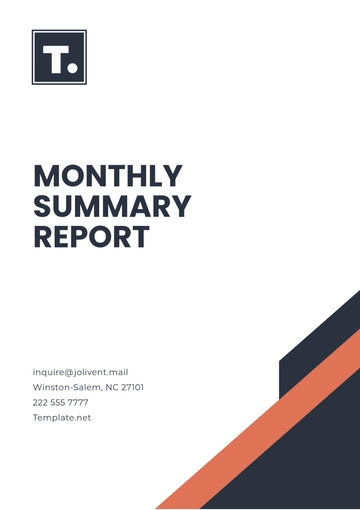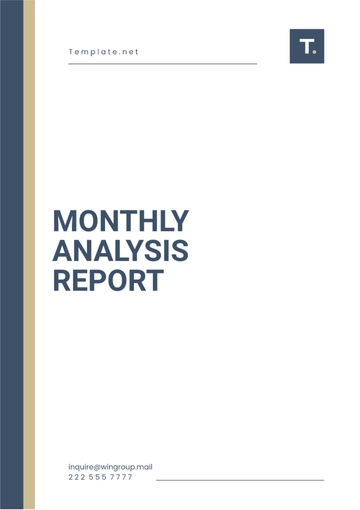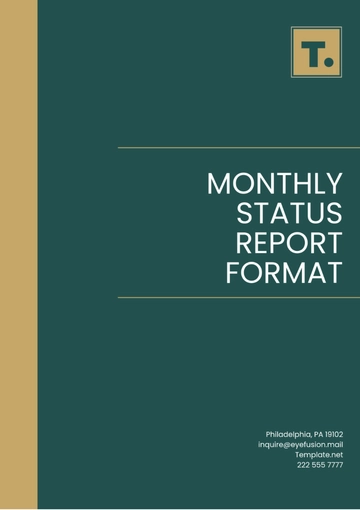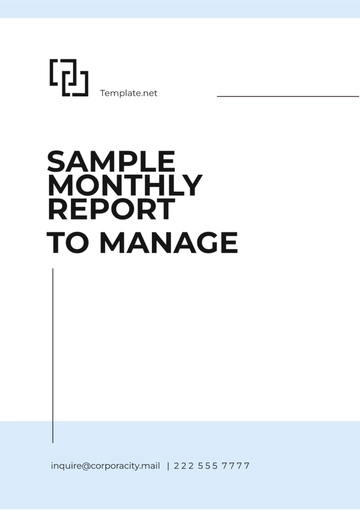Free Sales Protocol for Monthly Report Compilation
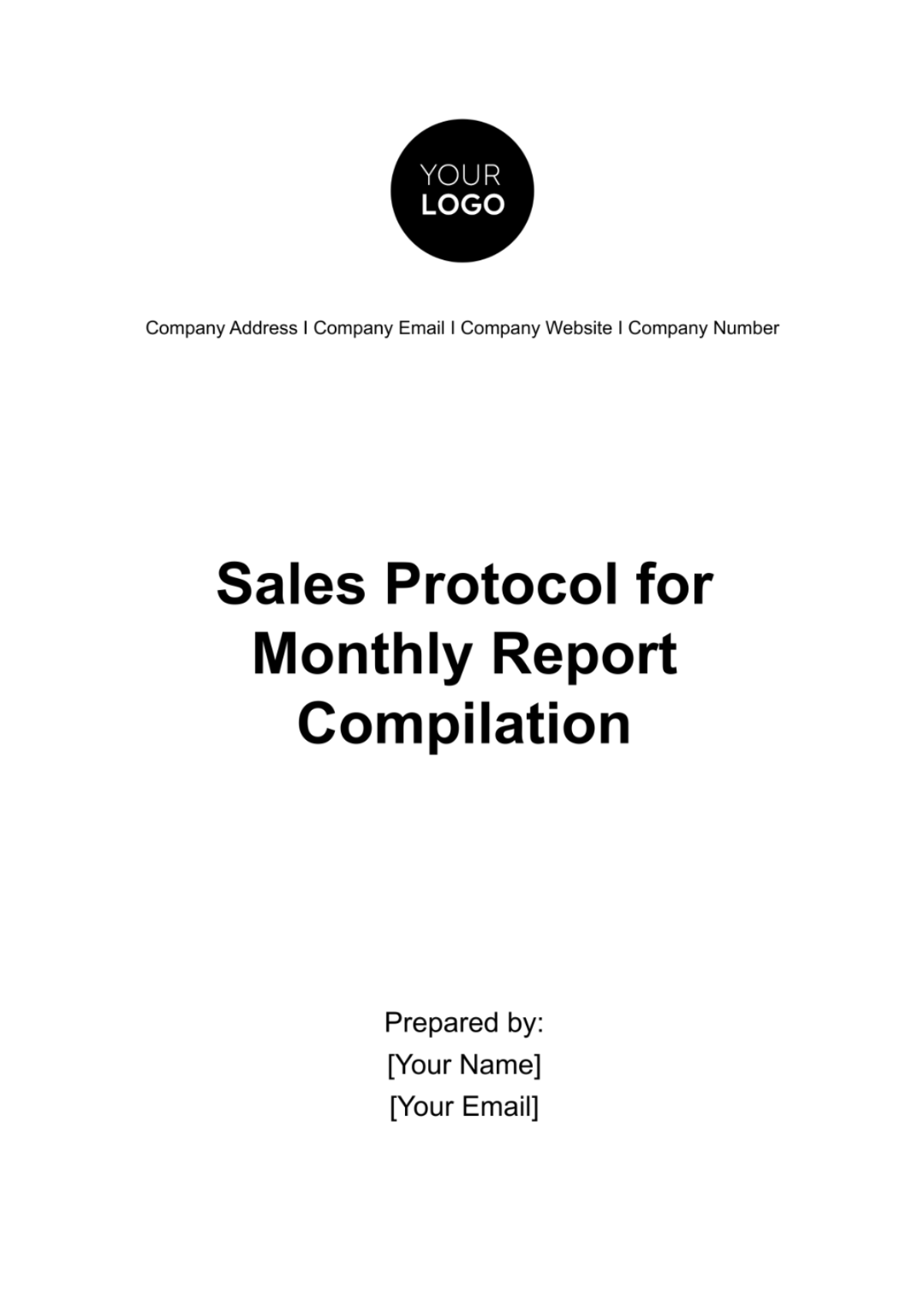
I. Introduction
The realm of sales is increasingly becoming data-intensive, making it crucial for businesses to adopt systematic reporting methods. Recognizing this, we have developed this Sales Protocol to serve as a foundational guide for standardizing the Monthly Sales Report Compilation at [Your Company Name]. The purpose of this document is to create an efficient, yet exhaustive process that captures essential metrics and data points from multiple sources within the organization. By doing so, we aim to facilitate a transparent and replicable reporting process that every department can understand and follow.
This protocol outlines the step-by-step procedures, defines the responsibilities of different departments, and identifies the specific tools to be used. Whether it's data from Customer Relationship Management (CRM) software or input from financial databases, we've identified key data sources to ensure that our monthly sales reports are comprehensive. We've also highlighted metrics that are critical to the evaluation of sales performance, such as Customer Acquisition Cost (CAC) and Monthly Recurring Revenue (MRR), among others. The guidelines mentioned herein also include submission deadlines and approval workflows to guarantee that the reports are not only accurate but are also timely.
The end goal is to ensure that every monthly sales report generated adheres to a consistent standard of quality and completeness, offering stakeholders at [Your Company Name] a reliable basis for making data-driven decisions. Following this protocol will enable us to track trends, understand customer behavior, and measure the effectiveness of sales strategies with greater accuracy.
II. Objectives
Overview:
The primary objectives of this Sales Protocol for Monthly Report Compilation are two-fold: first, to compile accurate monthly sales reports that can serve as a reliable basis for decision-making within [Your Company Name]; and second, to establish a systematic and standardized process for the gathering, analysis, and dissemination of pertinent sales data.
Compile Accurate Monthly Sales Reports
Importance:
Inaccurate or incomplete sales data can lead to misguided business decisions that could cost the company both time and resources. Accurate reports are therefore critical to gauge the true state of sales performance and to identify areas for improvement or investment.
Strategies for Achievement:
Data Validation: All data sources will be audited for accuracy.
Multiple Data Points: The report will use multiple metrics and data points to provide a comprehensive view of sales performance.
Expert Review: Before finalization, the report will undergo a rigorous review process involving department heads and financial experts.
Establish a Systematic Process for Gathering and Analyzing Sales Data
Importance:
A lack of a systematic process can lead to inefficiencies, such as duplicated work or missed data points. It can also make it challenging to compare data over time or across different segments of the business.
Strategies for Achievement:
Data Source Identification: Clearly identify and categorize data sources, including CRM software, financial software, and customer feedback systems.
Data Collection Procedure: Standardize the method for data collection and set deadlines for each stage of the process.
Data Analysis Tools: Select appropriate tools for data analysis and visualization, such as Tableau for visual insights and Python for more in-depth analytics.
By accomplishing these objectives, we aim to ensure that [Your Company Name]'s monthly sales reports are not only precise but are also generated through a streamlined, efficient process. This will empower our teams to better understand the data, thereby enabling more informed and strategic decision-making.
III. Sales Data Sources
One of the critical aspects of compiling an accurate and comprehensive monthly sales report lies in the quality of the data sources leveraged. This chapter outlines the primary data sources that will be utilized in generating [Your Company Name]'s monthly sales reports. For each source, we provide a brief description and designate the responsible team or individual who will be accountable for collecting and validating the data. The aim is to ensure that we capture the most relevant information that contributes to a nuanced understanding of our sales performance, customer behavior, and financial health.
Table: Sales Data Sources and Responsibilities
Data Source | Description | Responsible Team/Individual | Data Retrieval Frequency | Data Validation Method |
CRM Software | Customer interactions and sales funnel data | Sales Team | Daily/Weekly | Manual checks and automated audits |
Financial Software | Invoicing and revenue data | Accounting Team | Weekly/Monthly | Cross-referencing with bank transactions |
Customer Feedback | Customer reviews and ratings | Customer Support Team | After each customer interaction | Quality assurance reviews |
Inventory Management | Stock levels and sales rate | Operations Team | Daily/Weekly | Cross-check with physical counts and invoices |
Data Retrieval Frequency: This column is added to indicate how often the data needs to be retrieved from each source. For instance, CRM data might need daily or weekly updating, while financial data could be reviewed on a weekly or monthly basis.
Data Validation Method: Given that the accuracy of the data is crucial, we've included a column to outline the method used for validating each type of data. This could range from manual checks and cross-referencing to automated audits.
By clearly defining the data sources, their descriptions, and the teams responsible for them, along with the frequency and method of data retrieval and validation, we aim to establish a foolproof system for data collection that is both consistent and reliable. This approach will enable [Your Company Name] to compile monthly sales reports that are both robust and comprehensive.
IV. Data Collection Procedure
Efficient data collection is a linchpin in the creation of meaningful monthly sales reports. A well-defined data collection procedure helps streamline the process, reduces the likelihood of errors, and ensures timely report preparation. This section outlines the procedures to be followed for gathering data from various sources, including specific deadlines, data formats, and protocols for data integrity checks at [Your Company Name].
A. Data Retrieval Deadline
Importance:
Time-sensitive data retrieval ensures that reports are current and actionable. Failing to adhere to deadlines can result in outdated reports, which may mislead decision-making processes.
Guidelines:
Data for the monthly sales report must be retrieved and collated by the 3rd business day of the new month.
Each responsible team or individual should set internal deadlines to meet this organizational deadline, allowing time for data validation and any necessary corrections.
B. Data Format
Importance:
The format in which data is collected can significantly impact the ease and accuracy of subsequent data analysis. A uniform data format allows for quick aggregation and simplifies the analytic process.
Guidelines:
All data should be submitted in Excel or CSV format. This standardization will facilitate easier integration into analytic tools and ensure consistency across various data sources.
Templates for data submission will be provided to each responsible team, outlining the required fields and formats.
Additional Protocols:
Data Integration: Once the data is collated, it will be integrated into a centralized database to facilitate cross-analysis.
Data Validation: Before final inclusion in the report, the data will go through a validation process, including cross-referencing, outlier identification, and quality checks.
Backup: All data must be securely backed up, and confidential information should be encrypted to maintain data integrity and security.
By meticulously defining our data collection procedures and standards, we aim to create a consistent, repeatable process that ensures the quality and reliability of [Your Company Name]'s monthly sales reports. This will enable us to continually monitor performance, identify trends, and make data-driven decisions with confidence.
V. Sales Metrics
A well-designed monthly sales report is only as useful as the metrics it evaluates. Identifying and focusing on key sales metrics can provide deeper insights into the company’s sales health, guiding data-driven decision-making processes. This chapter outlines the key sales metrics that [Your Company Name] should include in its monthly sales reports. Each metric serves a distinct purpose, offering insights into different facets of the sales operation.
Table: Key Sales Metrics and Their Importance
Sales Metric | Description | Importance | Method of Calculation | Responsible Team |
Total Sales Revenue | The total income generated from sales activities | Offers an overarching view of sales performance, key for assessing overall business health | Sum of all sales transactions | Sales Team |
Customer Acquisition Cost (CAC) | Cost incurred to acquire a new customer | Useful for evaluating the efficiency of marketing efforts and determining profitability | Total Sales and Marketing Expenses / Number of New Customers Acquired | Marketing Team |
Customer Lifetime Value (CLV) | Projected revenue a customer will generate over their entire lifetime | Helps to understand customer profitability and guides customer retention strategies | (Average Spend per Transaction x Transaction Frequency) x Customer Lifespan | Sales and Customer Support Teams |
Monthly Recurring Revenue (MRR) | Predictable income generated from subscription-based sales | Crucial for businesses with a subscription model to assess sustainability and growth | Sum of all monthly subscription fees | Finance Team |
Customer Churn Rate | Percentage of customers lost during a specific period | Indicates customer satisfaction and retention, vital for long-term growth | (Number of Customers Lost / Number of Customers at Start of Period) x 100 | Customer Support Team |
Method of Calculation: This column specifies how each metric is to be calculated. It is critical to use standardized formulas to maintain data integrity and facilitate comparisons over time.
Responsible Team: This column identifies which department or team is responsible for calculating and validating each metric. Clearly defining these responsibilities ensures accuracy and accountability.
By explicitly stating these key sales metrics and their methods of calculation, we aim to standardize the reporting process at [Your Company Name]. This will help us in evaluating our sales strategies more effectively and in making informed, data-driven decisions.
VI. Report Compilation Methodology
Compiling a monthly sales report is a complex, multi-step process that involves various departments and layers of data. The Report Compilation Methodology serves as a roadmap that outlines the steps from data collection to final report dissemination within [Your Company Name]. Following a structured methodology ensures consistency, accuracy, and reliability in the final output, which in turn lends credibility to the insights drawn and decisions made based on the report.
Data Aggregation
Data aggregation is the first and perhaps one of the most crucial steps in our report compilation process. Every designated team or individual must collect all required data from their respective sources, ensuring they adhere to the data retrieval deadline, which is by the 3rd business day of each new month. This timeliness is essential for the reports to be current and actionable.
Data Cleaning
Once the data has been aggregated, the next step is data cleaning. This phase involves auditing the collated data for any errors, missing values, or discrepancies that could affect the accuracy of the final report. All anomalies are corrected, and the data is standardized to ensure consistency across the various data sets. Data cleaning is not merely a one-off task but a continuous process to maintain the quality of our reporting.
Data Analysis
After cleaning, the data is ready for in-depth analysis. Tools like Tableau are used for creating visual representations, such as charts and graphs, to make the data more understandable. Python scripts may be utilized for more sophisticated statistical analyses. The focus here is not just to summarize the data but to extract meaningful insights that can drive decision-making.
Draft Report
Once the data analysis is complete, an initial draft of the report is prepared. This draft includes all the key metrics, visual aids like charts and graphs, and annotations for added context. The draft serves as a comprehensive overview of sales performance for the month, capturing nuances that raw data alone cannot provide.
Internal Review
The draft report is then submitted for internal review by the 15th of each month. Team leads and relevant stakeholders scrutinize the document for accuracy, completeness, and alignment with organizational objectives. Feedback is collected and incorporated into the final report, ensuring that the document is both robust and reliable before it is disseminated to the broader organization.
By following this methodical approach to report compilation, [Your Company Name] aims to establish a benchmark for quality and reliability in our monthly sales reports. This methodology ensures that each report serves as a credible tool for assessing performance, identifying areas for improvement, and facilitating data-driven decision-making processes.
VII. Submission Guidelines
The final step in our monthly sales report compilation process at [Your Company Name] is the submission of the report. Properly submitting the completed report is crucial for ensuring that it reaches the intended recipients in a timely manner and in the correct format. This section outlines the specific guidelines for the email submission of the monthly sales report, including details on the submission deadline and the appropriate email subject line format. By adhering to these guidelines, we aim to standardize the submission process, thereby ensuring a smooth transition from report compilation to stakeholder review and action planning.
Email Submission: Send the final report to [Your Company Email] with the subject line "Monthly Sales Report: [Month], 2050."
Submission Deadline: All final reports should be submitted by the 20th of each month.
VIII. Approval Process
Following the submission of the monthly sales report, it enters an approval process to ensure the document's integrity, accuracy, and relevance. This section delineates the sequential steps that the report must go through within [Your Company Name] before it can be considered final and actionable. Involving key stakeholders such as the Senior Sales Manager, the CFO, and the CEO, this multi-tiered approval process is designed to validate both the qualitative and quantitative aspects of the report, thereby ensuring it is a reliable basis for strategic decision-making.
IX. Review and Feedback
After navigating the stringent approval process, the monthly sales report doesn't simply gather digital dust; it serves as a launching pad for discussion, feedback, and action planning. This chapter outlines the post-approval procedures for the report within [Your Company Name], focusing on its distribution and the subsequent review process. By ensuring that the report reaches all relevant departments and serves as the centerpiece for regular review meetings, we aim to transform the data and insights it contains into concrete strategies and actions.
Once approved, the report will be disseminated to all relevant departments.
A monthly review meeting will be held to discuss the findings and to address any queries.
X. Conclusion
Following this Sales Protocol for Monthly Report Compilation will ensure that [Your Company Name]'s sales reports are accurate, timely, and actionable. Adherence to this protocol is mandatory for all teams and individuals involved in the sales reporting process.
For any queries or clarifications, please contact [Your Name] at [Your Email] or [Your Number].
- 100% Customizable, free editor
- Access 1 Million+ Templates, photo’s & graphics
- Download or share as a template
- Click and replace photos, graphics, text, backgrounds
- Resize, crop, AI write & more
- Access advanced editor
Streamline your monthly sales reporting with our Sales Protocol for Monthly Report Compilation Template from Template.net. This editable and customizable tool empowers you to effortlessly gather, analyze, and present sales data. Harness the power of our AI Editor Tool to generate insightful reports, ensuring accuracy and efficiency in every step of your sales process.
You may also like
- Sales Report
- Daily Report
- Project Report
- Business Report
- Weekly Report
- Incident Report
- Annual Report
- Report Layout
- Report Design
- Progress Report
- Marketing Report
- Company Report
- Monthly Report
- Audit Report
- Status Report
- School Report
- Reports Hr
- Management Report
- Project Status Report
- Handover Report
- Health And Safety Report
- Restaurant Report
- Construction Report
- Research Report
- Evaluation Report
- Investigation Report
- Employee Report
- Advertising Report
- Weekly Status Report
- Project Management Report
- Finance Report
- Service Report
- Technical Report
- Meeting Report
- Quarterly Report
- Inspection Report
- Medical Report
- Test Report
- Summary Report
- Inventory Report
- Valuation Report
- Operations Report
- Payroll Report
- Training Report
- Job Report
- Case Report
- Performance Report
- Board Report
- Internal Audit Report
- Student Report
- Monthly Management Report
- Small Business Report
- Accident Report
- Call Center Report
- Activity Report
- IT and Software Report
- Internship Report
- Visit Report
- Product Report
- Book Report
- Property Report
- Recruitment Report
- University Report
- Event Report
- SEO Report
- Conference Report
- Narrative Report
- Nursing Home Report
- Preschool Report
- Call Report
- Customer Report
- Employee Incident Report
- Accomplishment Report
- Social Media Report
- Work From Home Report
- Security Report
- Damage Report
- Quality Report
- Internal Report
- Nurse Report
- Real Estate Report
- Hotel Report
- Equipment Report
- Credit Report
- Field Report
- Non Profit Report
- Maintenance Report
- News Report
- Survey Report
- Executive Report
- Law Firm Report
- Advertising Agency Report
- Interior Design Report
- Travel Agency Report
- Stock Report
- Salon Report
- Bug Report
- Workplace Report
- Action Report
- Investor Report
- Cleaning Services Report
- Consulting Report
- Freelancer Report
- Site Visit Report
- Trip Report
- Classroom Observation Report
- Vehicle Report
- Final Report
- Software Report

